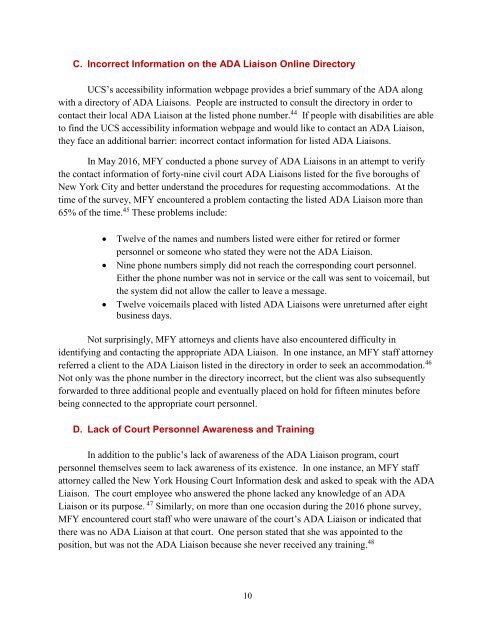Barriers to Justice
kAst305MjV6
kAst305MjV6
You also want an ePaper? Increase the reach of your titles
YUMPU automatically turns print PDFs into web optimized ePapers that Google loves.
C. Incorrect Information on the ADA Liaison Online Direc<strong>to</strong>ry<br />
UCS’s accessibility information webpage provides a brief summary of the ADA along<br />
with a direc<strong>to</strong>ry of ADA Liaisons. People are instructed <strong>to</strong> consult the direc<strong>to</strong>ry in order <strong>to</strong><br />
contact their local ADA Liaison at the listed phone number. 44 If people with disabilities are able<br />
<strong>to</strong> find the UCS accessibility information webpage and would like <strong>to</strong> contact an ADA Liaison,<br />
they face an additional barrier: incorrect contact information for listed ADA Liaisons.<br />
In May 2016, MFY conducted a phone survey of ADA Liaisons in an attempt <strong>to</strong> verify<br />
the contact information of forty-nine civil court ADA Liaisons listed for the five boroughs of<br />
New York City and better understand the procedures for requesting accommodations. At the<br />
time of the survey, MFY encountered a problem contacting the listed ADA Liaison more than<br />
65% of the time. 45 These problems include:<br />
<br />
<br />
<br />
Twelve of the names and numbers listed were either for retired or former<br />
personnel or someone who stated they were not the ADA Liaison.<br />
Nine phone numbers simply did not reach the corresponding court personnel.<br />
Either the phone number was not in service or the call was sent <strong>to</strong> voicemail, but<br />
the system did not allow the caller <strong>to</strong> leave a message.<br />
Twelve voicemails placed with listed ADA Liaisons were unreturned after eight<br />
business days.<br />
Not surprisingly, MFY at<strong>to</strong>rneys and clients have also encountered difficulty in<br />
identifying and contacting the appropriate ADA Liaison. In one instance, an MFY staff at<strong>to</strong>rney<br />
referred a client <strong>to</strong> the ADA Liaison listed in the direc<strong>to</strong>ry in order <strong>to</strong> seek an accommodation. 46<br />
Not only was the phone number in the direc<strong>to</strong>ry incorrect, but the client was also subsequently<br />
forwarded <strong>to</strong> three additional people and eventually placed on hold for fifteen minutes before<br />
being connected <strong>to</strong> the appropriate court personnel.<br />
D. Lack of Court Personnel Awareness and Training<br />
In addition <strong>to</strong> the public’s lack of awareness of the ADA Liaison program, court<br />
personnel themselves seem <strong>to</strong> lack awareness of its existence. In one instance, an MFY staff<br />
at<strong>to</strong>rney called the New York Housing Court Information desk and asked <strong>to</strong> speak with the ADA<br />
Liaison. The court employee who answered the phone lacked any knowledge of an ADA<br />
Liaison or its purpose. 47 Similarly, on more than one occasion during the 2016 phone survey,<br />
MFY encountered court staff who were unaware of the court’s ADA Liaison or indicated that<br />
there was no ADA Liaison at that court. One person stated that she was appointed <strong>to</strong> the<br />
position, but was not the ADA Liaison because she never received any training. 48<br />
10


